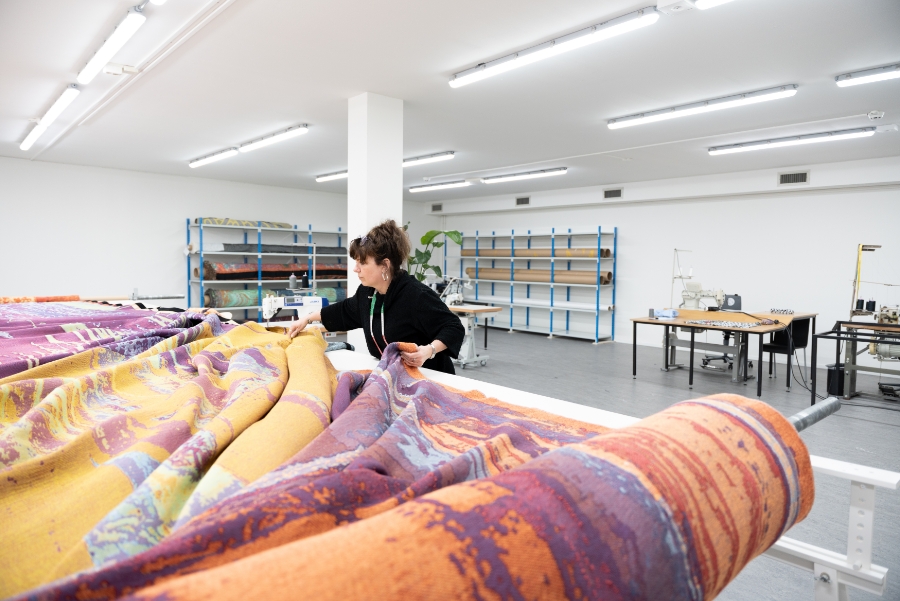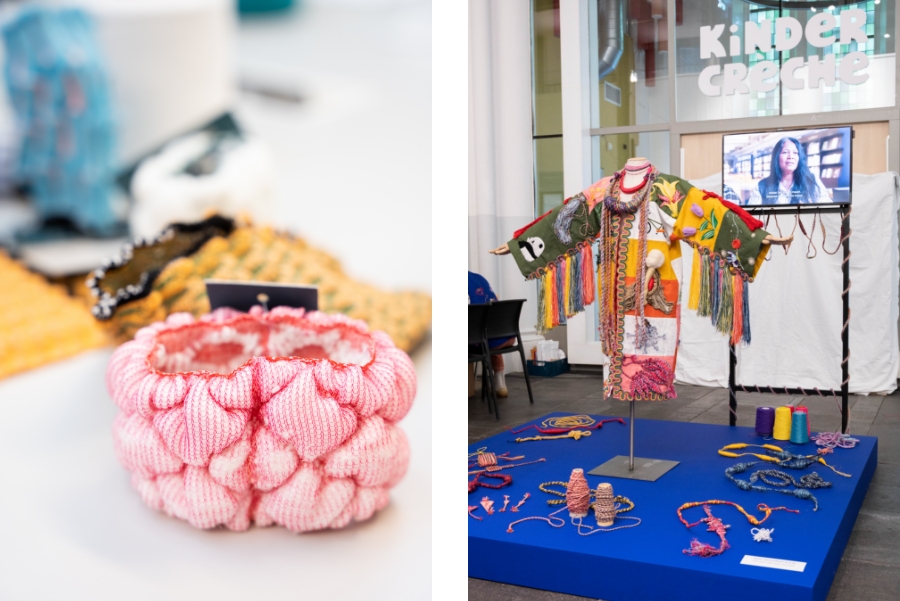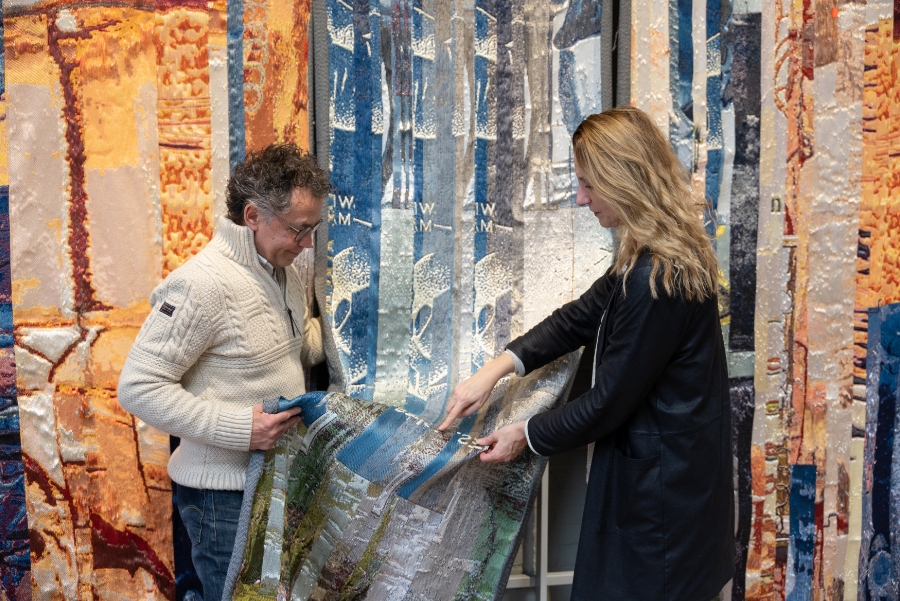The TextielLab recently opened a new assembly atelier. In the Dröge building behind the museum, the assembly team led by Ingrid Staps finishes the larger works. Their first project was Laurence Aëgerter’s 40-metre tapestry ‘Epic of the Mind’.
As the machines in the TextielLab become larger and more advanced, so do the works of art and product designs created. It became impossible to carry them up the stairs to the current assembly atelier on the second floor. The Dröge building behind the museum offered a solution. It was turned into a more spacious atelier, where works can simply be wheeled in on a cart. The atelier was inaugurated with the completion of Laurence Aëgerter’s new masterpiece: ‘Epic of the Mind’. This immense tapestry, which is 40 metres long and weighs almost 100 kilos, has considerably accelerated the deployment of the new space, says Ingrid Staps, who heads the atelier. By pushing several mobile tables together to create a surface of 3.5 metres by 6 metres, she was able to lay out large sections of the fabric and begin finishing it. It was a challenging job: “Thirty centimetres had to be cut off the top, which is quite nerve-wracking if you can’t unroll the fabric fully. Product developer Stef Miero had therefore woven markers into the fabric as a guide and to show where the Velcro for the hanging system should be sewn on. At Laurence’s request, I did several tests with the topstitching of the cover that the Velcro is attached to, but it didn’t look nice. I ended up sewing on the entire tunnel by hand. It took almost three weeks to do.”

Ingrid Staps in the new assembly atelier with the tapestry ‘Epic of the Mind’ by Laurence Aëgerter. Photo: Patty van den Elshout
Loose ends
Many of the works that are developed in the TextielLab pass through the assembly atelier, even if they do not have to be finished with needle and thread. The pieces are carefully checked for loose threads, weaving or knitting errors and knots. “We fix them all,” says Staps, “we aim for perfection.” She has a background in education, and taught dressmaking and textile methods for 25 years. When she came to work at the museum three years ago, she was tasked with taking the assembly department to the next level – something the team of four, along with two interns and lab coordinator Gerard Kuijpers, have worked hard to achieve. The new atelier, which better meets the needs of product developers and designers, is part of this ambition. Kuijpers had new tables on wheels made especially for the space so that the set-up can be adapted per project. The new backstitch and lockstitch machines are also mobile and can be moved to the finishing table – a 100 kilo tapestry isn’t easy to lift, after all.
Openwork tunnels
Documenting the working process is also part of professionalising the department. For each piece, an accompanying assembly sheet includes a description of the work and material. This is stored in a database together with photos of the final result, so that all the steps and techniques can be referred to in the future. These vary from hemming and attaching tunnels to woven tapestries to sewing and overlocking knits. As knitting becomes more popular, the assembly team is also investing in its capacity in this area. For example, workshops were organised for the team to learn how to repair knitwear. They also conduct extensive research into attractive finishes for knitted pieces, such as Sigrid Calon’s throws. These blankets are now in production, featuring a lockstitch in two colours.
“We are the final stop in the entire creative process.”
Museum pieces
Staps is equally enthusiastic about Sangmin Oh’s ‘Knitted Lights’, which she sewed together by hand. “I wrecked my fingers on the hard monofilament, but it was a really fun project to do.” Other special projects include assembling Margriet Luyten’s cloak for the statue of the Virgin Mary in St. John’s Cathedral in Den Bosch, and a coat for the Connecting threads collaborative project. She stresses that every work is treated with great love and attention, and that the team is aware of their impact on the end result. “You can make a stunning work of art, but if it doesn’t hang properly, it won’t look right. The technical finish is – literally – the finishing touch, and very important for the appearance of a work. We are the final stop in the entire creative process.”

Knitted Light by Sangmin Oh. Photo: Patty van den Elshout / ‘a coat of many colors’ by Bindweefsel. Photo: Kevita Junior.
Kick
Staps often goes to see what the works look like once they go on display in museums. She visited the Stedelijk Museum in Amsterdam to view the tapestry by Mercedes Azpilicueta, which was finished in the old assembly atelier. “A fabric like that goes through your hands so often, it contains my DNA. And it hung wonderfully. I’ll definitely visit Laurence’s tapestry when it is exhibited in the Dolhuys in Haarlem this summer. It turned out so beautifully, it will be a kick to see it hanging there.”

Stef Miero and Laurence Aëgerter view ‘Epic of the Mind’ in the TextielLab. Photo: Patty van den Elshout
‘Epic of the Mind’ can be seen from 21 June 2023 to May 2024 as part of Laurence Aëgerter’s solo exhibition in Museum van de Geest, in the Dolhuys in Haarlem.